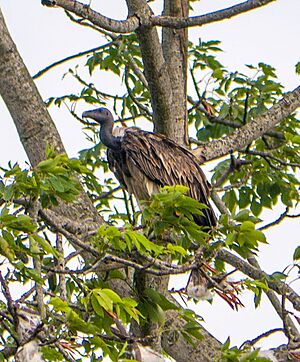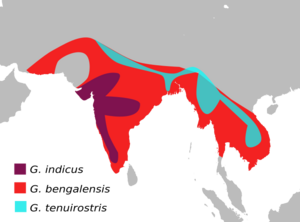Slender-billed vulture facts for kids
Quick facts for kids Slender-billed vulture |
|
|---|---|
 |
|
| Slender-billed Vulture in Arunachal Pradesh, India | |
| Conservation status | |
| Scientific classification | |
| Genus: |
Gyps
|
| Species: |
tenuirostris
|
 |
|
| Distribution in blue | |
| Synonyms | |
|
Gyps indicus tenuirostris |
|
The slender-billed vulture (Gyps tenuirostris) is a large bird of prey. It is a type of Old World vulture. These vultures live in parts of Asia, especially near the Himalayan mountains and in Southeast Asia.
Sadly, the slender-billed vulture is in great danger. Since 2002, it has been listed as Critically Endangered. This means its population has dropped very quickly. In 2021, scientists thought fewer than 870 adult birds were left.
This vulture used to be grouped with the Indian vulture. But they are different species. The Indian vulture lives south of the Ganges River and builds nests on cliffs. The slender-billed vulture lives along the Ganges and builds its nests in trees.
What Does It Look Like?
This vulture is a medium-sized bird. It is about 80 to 95 centimeters (31 to 37 inches) long. This is similar in size to its close relative, the Indian vulture.
Most of its body is grey. It has a lighter grey area near its tail. Its upper legs have soft, whitish feathers. The neck is long, thin, and black, with no feathers. Its head is also black, narrow, and has a dark, thin beak. You can easily see its ear opening.
Where Do They Live?
The slender-billed vulture lives in several Asian countries. In India, you can find them from the Gangetic plain northwards. They are also in Himachal Pradesh and possibly northern Odisha. They live east through Assam.
You can also find them in central and northern Bangladesh. They are in southern Nepal, Burma (now called Myanmar), and Cambodia.
Why Are They in Danger?
The number of slender-billed vultures has dropped a lot recently. Between 2000 and 2007, the populations of this species and the Indian vulture fell by 97%. In India, their numbers went down by over 16% each year.
Some wild groups still live in northern and eastern India. Others are in southern Nepal and Bangladesh. A small group is also found in Burma. The only known place where they breed in Southeast Asia is in Cambodia. This group might have about 50 to 100 birds.
One reason these vultures are disappearing is a medicine called diclofenac. This medicine is given to farm animals to help them. But it is very poisonous to vultures. When vultures eat the meat of animals treated with diclofenac, it causes their kidneys to fail.
In India, it is now against the law to sell diclofenac for animals. However, some people still get it illegally. Scientists are trying to replace diclofenac with a safer medicine called meloxicam. Meloxicam does not harm vultures.
Helping the Vultures
Many groups are working to save the slender-billed vulture. They are trying to breed these birds in special centers. This is called a captive breeding program. The goal is to raise young vultures in a safe place. Then, they can be released back into the wild. This can happen once the environment is free of diclofenac.
The Royal Society for the Protection of Birds (RSPB) and the Zoological Society of London are working together. In 2009, they had their first success. Two slender-billed vultures hatched in captivity. These young birds are now being cared for in Haryana and West Bengal, India.


